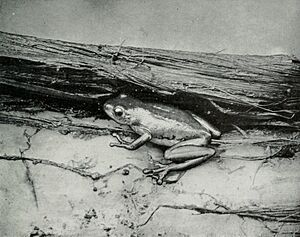Hyperolius picturatus facts for kids
Quick facts for kids Hyperolius picturatus |
|
|---|---|
 |
|
| Conservation status | |
| Scientific classification | |
| Synonyms | |
|
Rappia picturata (Peters, 1875) |
The Variable Reed Frog (Hyperolius picturatus) is a small, colorful frog. It belongs to the family Hyperoliidae, also known as "reed frogs." You can find this frog in West Africa. Its home includes countries like Sierra Leone, Guinea, Liberia, Ivory Coast, and Ghana. It might even live in Togo. People sometimes call it the "Tanzania reed frog," but that's a bit confusing. It doesn't actually live in Tanzania! Another name for it is the "variable montane sedge frog."
Contents
What Kind of Frog Is It?
The Variable Reed Frog is a very interesting species. Scientists use the word "variable" because these frogs can look quite different from each other. It's possible that what we call Hyperolius picturatus is actually two different kinds of frogs. These two types might live in the same areas. Scientists are still studying if they are separate "cryptic species" or just different subspecies.
What Does the Variable Reed Frog Look Like?
These frogs are quite small. Male Variable Reed Frogs are about 21 to 31 millimeters long. That's about the size of a large paperclip! Females are a bit bigger, measuring 26 to 34 millimeters.
Male frogs often have a special pattern on their backs. It looks like an hourglass shape. They might also have wide stripes along their sides. Female frogs usually have a plain back. They often have wide, light stripes on their sides and dark areas on their flanks. All Variable Reed Frogs have horizontal pupils in their eyes.
Sounds of the Male Frog
When a male Variable Reed Frog wants to attract a mate, it makes a special call. This call starts with one sound. After that, it makes a series of clicking noises. These calls help other frogs find them.
Where Does the Variable Reed Frog Live?
The Variable Reed Frog likes to live in certain places. You can often find them in "secondary forests." These are forests that have grown back after being cut down. They also live in clearings within forests. If there are still many tall trees, they can even live in areas where the forest has been heavily changed. This includes places like old farms or sugar cane fields.
They usually only live near large rivers in primary forests. These are forests that have never been cut down.
Reproduction and Breeding Habits
Variable Reed Frogs need water to lay their eggs. They breed in flowing water. This can be anything from a very small, slow-moving stream to a fast-flowing mountain river. Male frogs hide themselves well when they call out. They often call from inside bushes. This makes them very hard to find!
Protecting the Variable Reed Frog
Even though these frogs are not always common, you can find many of them in some places. The Variable Reed Frog is quite good at adapting to changes in its home. However, it can still be in danger if its habitat is destroyed. This happens when forests are cut down or changed too much.
Good news! This frog lives in many protected areas. Examples include Mont Sângbé National Park and Forêt Classée du Pic de Fon. Because it can adapt and lives in protected places, the International Union for Conservation of Nature (IUCN) says it is a species of "Least Concern." This means it is not currently at high risk of disappearing.


